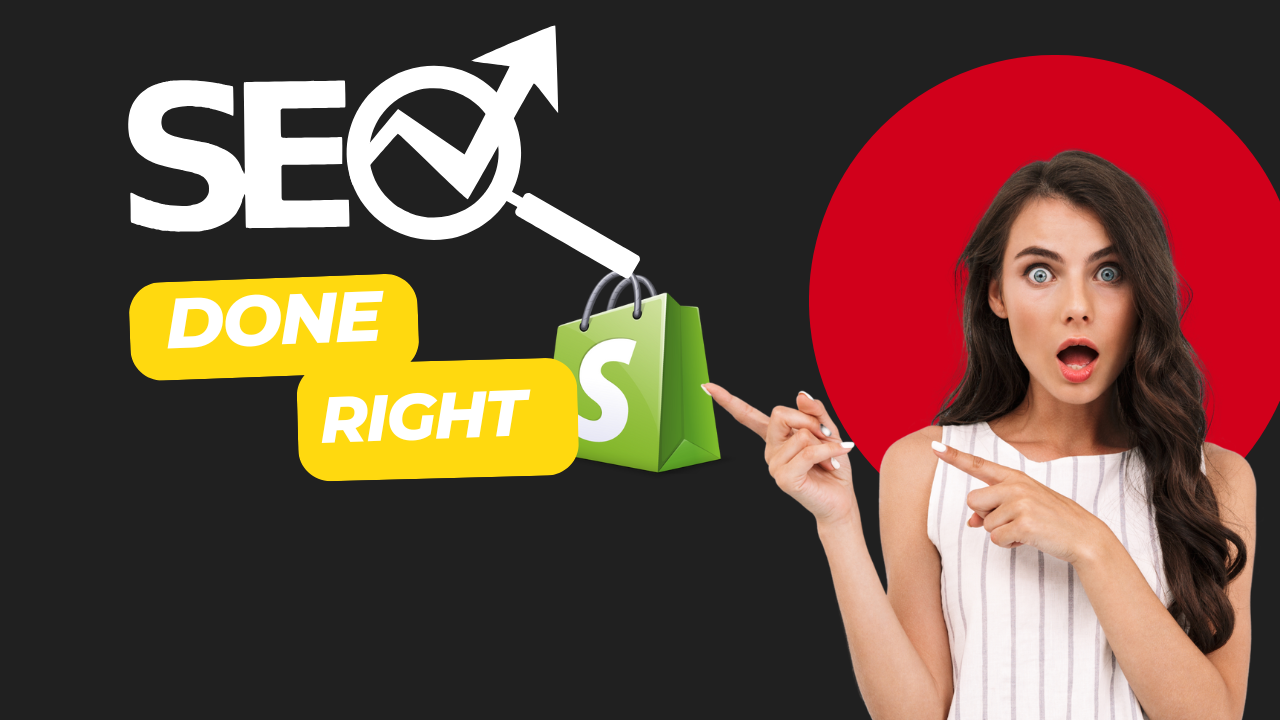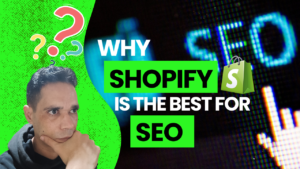
Shopify has emerged as a dominant force in e-commerce, empowering entrepreneurs worldwide to launch and manage their online stores with remarkable ease. However, simply setting up a Shopify store doesn’t guarantee success. In the crowded digital marketplace, visibility is paramount, and that’s where Search Engine Optimization (SEO) comes into play. For a Shopify store, effective SEO is not just about ranking high; it’s about attracting qualified traffic – visitors actively searching for the products you sell – and converting them into loyal customers.
This comprehensive guide will delve deep into the world of SEO for Shopify stores, providing actionable strategies and insights to help you climb the search engine rankings, drive organic traffic, and ultimately boost your sales.
The Foundation: Understanding E-commerce SEO
Before we dive into specific Shopify tactics, it’s crucial to grasp the fundamental principles of e-commerce SEO. Unlike traditional websites, online stores have unique SEO considerations due to their product-centric nature.
What is E-commerce SEO? E-commerce SEO is the process of optimizing your online store to rank higher in search engine results pages (SERPs) for relevant product and category keywords. This involves a blend of technical optimization, on-page content enhancement, and off-page authority building, all aimed at improving your store’s visibility and attracting potential customers.
Why is SEO Crucial for a Shopify Store?
- Organic Traffic is Free (Mostly): While paid advertising offers instant visibility, organic traffic, once earned, is a sustainable and cost-effective source of visitors.
- Higher Conversion Rates: Users searching for specific products often have high purchase intent. Ranking for these transactional keywords can lead to better conversion rates.
- Builds Trust and Credibility: Appearing high in search results builds trust with potential customers, as it signals authority and relevance in your niche.
- Long-Term Growth: SEO is an ongoing process that yields compounding returns over time, contributing to sustained business growth.
- Competitive Advantage: In a marketplace saturated with Shopify stores, strong SEO can differentiate your brand and capture market share.
Pillar 1: Keyword Research for E-commerce Success
Keyword research is the bedrock of any successful SEO strategy. For a Shopify store, this means identifying the terms and phrases your target customers use when searching for products like yours.
Strategies for E-commerce Keyword Research:
- Brainstorm Seed Keywords: Start by listing broad terms related to your products, categories, features, benefits, and even problems your products solve. Think like your customer.
- Example: If you sell organic tea, seed keywords might include “organic tea,” “herbal tea,” “loose leaf tea,” “detox tea,” “sleep tea.”
- Expand Your Keyword List with Tools: Utilize keyword research tools (e.g., Ahrefs, Semrush, Google Keyword Planner, Shopify’s own keyword tools, Ubersuggest) to find related keywords, synonyms, long-tail variations, and competitor insights.
- Look for keywords with a good balance of search volume and manageable competition.
- Pay attention to buyer intent:
- Informational: “benefits of green tea”
- Navigational: “Teavana store locator”
- Transactional: “buy organic green tea online,” “best loose leaf tea for anxiety”
- Commercial Investigation: “best brand of herbal tea”
- Analyze Competitors: See what keywords your top competitors are ranking for. This can uncover lucrative opportunities you might have missed.
- Prioritize and Map Keywords:
- Prioritize keywords based on relevance, search volume, and difficulty.
- Map keywords to specific pages on your Shopify store:
- Product Pages: Target highly specific, transactional keywords (e.g., “Men’s Waterproof Hiking Boots – Size 10”).
- Collection Pages: Target broader category keywords (e.g., “Hiking Boots,” “Waterproof Footwear”).
- Blog Posts: Target informational and commercial investigation keywords (e.g., “How to Choose the Right Hiking Boots,” “Best Hiking Trails in [Your Region]”).
- Utilize Google Search Console: This free tool shows you what keywords you’re already ranking for and highlights any indexing issues.
Pillar 2: On-Page SEO for Shopify Optimization
On-page SEO refers to all the optimizations you make directly on your Shopify store’s pages. This tells search engines what your content is about and helps them rank it appropriately.
Key On-Page Elements for Shopify:
- Product Page Optimization: These are your money pages, so optimize them meticulously.
- Product Titles: Include your main keyword naturally at the beginning. Make them descriptive and appealing to users. (e.g., instead of “T-shirt,” use “Organic Cotton V-Neck T-Shirt – Blue”).
- Meta Titles and Descriptions: These appear in search results.
- Title Tag: (HTML title) Keep it under 60 characters, include your primary keyword, and make it compelling.
- Meta Description: A brief summary (155-160 characters) that encourages clicks. Include keywords and a call to action.
- Product Descriptions: Write unique, detailed, and engaging descriptions that go beyond basic features. Incorporate relevant keywords naturally, answer potential customer questions, and highlight benefits. Use headings, bullet points, and clear formatting for readability.
- Product Images:
- Optimize File Size: Compress images to reduce page load times without sacrificing quality. Shopify automatically compresses, but pre-optimizing is better.
- Descriptive Alt Text: Describe the image content using relevant keywords. This helps search engines understand the image and improves accessibility.
- Descriptive File Names: Use keywords in your image file names (e.g.,
organic-cotton-v-neck-tshirt-blue.jpg).
- Product Reviews: Encourage customers to leave reviews. User-generated content with relevant keywords can significantly boost your product page SEO and build trust.
- Collection Page Optimization:
- Collection Titles & Descriptions: Optimize these with relevant category keywords. Write unique descriptions that provide value and context.
- Internal Linking: Link from collection descriptions to specific product pages within that collection.
- Blog Posts: A blog is vital for attracting informational searchers and building authority.
- Target Informational Keywords: Create valuable content that answers questions, provides guides, or offers comparisons.
- Internal Linking: Link from your blog posts to relevant product and collection pages. This distributes “link juice” and helps users discover your products.
- External Linking: Link to authoritative external resources where appropriate.
- URL Structure: Shopify’s default URL structure can sometimes create issues (e.g.,
/collections/collection-name/products/product-name). While Shopify handles canonical tags for duplicate content, strive for clean, keyword-rich, and user-friendly URLs where possible.- Keep them short and descriptive.
- Use hyphens to separate words.
- Include your main keyword.
- Heading Tags (H1, H2, H3, etc.): Use headings to structure your content logically and make it scannable for both users and search engines. Your page title is typically the H1. Use H2s for subheadings and H3s for further sub-sections, naturally incorporating keywords.
Pillar 3: Technical SEO for Shopify
Technical SEO ensures that search engines can easily crawl, index, and understand your Shopify store. Shopify handles many technical aspects, but some require your attention.
- Site Speed: Page load speed is a critical ranking factor and user experience element.
- Optimize Images: As mentioned, compress and resize images.
- Choose a Fast Theme: Select a lightweight, speed-optimized Shopify theme.
- Limit Apps: Too many apps can slow down your store. Uninstall unused apps.
- Lazy Loading: Enable lazy loading for images and videos so they only load when a user scrolls to them.
- Embed Videos: Host videos on platforms like YouTube and embed them, rather than uploading directly to Shopify.
- Minimize Redirects: Avoid redirect chains.
- Mobile-Friendliness: Shopify themes are generally responsive, but always test your store’s appearance and functionality on various mobile devices. Google’s mobile-first indexing means this is non-negotiable.
- Sitemaps: Shopify automatically generates a sitemap.xml file. Ensure it’s submitted to Google Search Console to help Google discover all your important pages.
- Robots.txt: Shopify generates a robots.txt file to instruct search engine crawlers. While you typically can’t edit it directly, ensure it’s not blocking important pages from being indexed.
- Canonical Tags: Shopify generally handles canonical tags to prevent duplicate content issues (e.g., a product accessible via both
/products/product-nameand/collections/collection-name/products/product-name). Verify that these are correctly implemented, as duplicate content can dilute SEO efforts. - Structured Data (Schema Markup): This is code that helps search engines understand the context of your content, leading to rich snippets (enhanced search results like star ratings, product prices, and availability).
- For Shopify products,
Productschema is crucial, including properties likename,image,description,sku,price,currency,aggregateRating, andreview. - Shopify apps can help implement structured data, or it can be added manually to your theme files (requires technical expertise).
- For Shopify products,
- Google Search Console & Google Analytics:
- Google Search Console: Monitor your store’s performance in search, identify crawling errors, indexing issues, and see which keywords are driving traffic.
- Google Analytics: Track organic traffic, conversions, user behavior, and other key metrics to measure your SEO progress.
Pillar 4: Off-Page SEO and Authority Building
Off-page SEO refers to activities performed outside your Shopify store to improve its ranking, primarily through building high-quality backlinks.
- Link Building: Backlinks from authoritative and relevant websites signal to search engines that your store is trustworthy and valuable.
- Guest Blogging: Write articles for industry-related blogs and include a link back to your Shopify store.
- Product Reviews/Mentions: Reach out to bloggers, influencers, and media outlets in your niche to review or feature your products.
- Unlinked Brand Mentions: Search for instances where your brand is mentioned online without a link and request the site owner to add one.
- Broken Link Building: Find broken links on relevant websites and suggest your content as a replacement.
- Digital PR: Create compelling content (e.g., original research, infographics, unique guides) that attracts media attention and natural backlinks.
- Resource Pages: Get your store or specific products listed on “resource” or “best of” pages in your industry.
- Affiliate Partnerships: While primarily a sales strategy, affiliate relationships can also lead to valuable backlinks.
- Social Media Engagement: While social signals aren’t direct ranking factors, an active social media presence can:
- Drive traffic to your store, increasing overall visibility.
- Increase brand awareness and recognition.
- Lead to more organic mentions and shares, indirectly contributing to SEO.
- Local SEO (if applicable): If you have a physical presence or target a local customer base, optimize for local search.
- Google Business Profile: Create and optimize your Google Business Profile listing with accurate information, photos, and customer reviews.
- Local Citations: Ensure your business name, address, and phone number (NAP) are consistent across all online directories.
Pillar 5: Content Marketing for Shopify Growth
Content marketing is a powerful long-term SEO strategy for Shopify stores. It attracts, engages, and converts your target audience by providing valuable, relevant, and consistent content.
- Blogging: As mentioned, a blog is essential. Beyond product-focused content, consider:
- How-to guides: (e.g., “How to Brew the Perfect Cup of [Your Tea]”)
- Buyer’s guides: (e.g., “The Ultimate Guide to Choosing Running Shoes”)
- “Best of” lists: (e.g., “Top 5 Sustainable Brands for Home Decor”)
- Industry news and trends: Keep your audience informed.
- Behind-the-scenes content: Build brand personality and trust.
- Video Marketing: Product videos, tutorials, unboxings, and lifestyle videos can be highly engaging and shareable, driving traffic and potential backlinks. Host them on YouTube for broader reach.
- User-Generated Content (UGC): Encourage customers to share photos, videos, and testimonials. This builds social proof, provides fresh content, and can lead to more organic visibility.
- FAQs and Knowledge Bases: Address common customer questions directly on your product pages or in a dedicated FAQ section. This can help you rank for long-tail, question-based keywords.
Shopify SEO Apps and Tools
Shopify’s App Store offers numerous SEO apps that can streamline your optimization efforts. While many tasks can be done manually, these tools can save time and provide valuable insights.
Popular Shopify SEO Apps:
- Plug in SEO: Checks your store for SEO issues and suggests fixes.
- Smart SEO: Automates meta tag and alt tag generation.
- TinyIMG / SEO Image Optimizer: Optimizes images for speed and SEO.
- JSON-LD for SEO: Helps implement structured data for rich snippets.
- SEO Manager: Offers a suite of SEO tools for various optimizations.
General SEO Tools (External):
- Google Search Console: Essential for monitoring performance and identifying issues.
- Google Analytics: For tracking traffic, conversions, and user behavior.
- Ahrefs / Semrush / Moz: Comprehensive SEO suites for keyword research, competitor analysis, backlink analysis, and site audits.
- Screaming Frog: A website crawler for technical SEO audits.
Common Shopify SEO Mistakes to Avoid
Even with the right strategies, common pitfalls can hinder your Shopify store’s SEO.
- Ignoring Keyword Research: Don’t guess what your customers are searching for.
- Duplicate Content: Shopify can sometimes generate duplicate content (e.g., product pages accessible via different URLs). While canonical tags help, ensure unique content for product descriptions, collection descriptions, and blog posts.
- Poor Image Optimization: Large, unoptimized images slow down your site and miss out on image search opportunities.
- Neglecting Mobile Optimization: A slow or non-responsive mobile experience will hurt your rankings and user experience.
- Keyword Stuffing: Overloading your content with keywords looks unnatural and can be penalized by search engines. Write for humans first.
- Ignoring Site Speed: A slow website frustrates users and impacts rankings.
- Lack of Internal Linking: Fail to connect relevant pages within your store, hindering crawlability and link equity flow.
- Not Building Backlinks: Without quality backlinks, your store’s authority and ranking potential will be limited.
- Failing to Monitor Performance: SEO is not a “set it and forget it” task. Regularly track your rankings, traffic, and conversions to adjust your strategy.
- Having an Empty Blog: A static blog signals to Google that your site isn’t regularly updated or providing fresh value.
Measuring SEO Success for Your Shopify Store
To ensure your SEO efforts are paying off, you need to track key performance indicators (KPIs).
- Organic Traffic: Monitor the number of visitors coming to your store from search engines. Look at trends over time.
- Keyword Rankings: Track your position in SERPs for your target keywords.
- Organic Conversions & Revenue: This is the ultimate metric. How much revenue is directly attributable to organic search traffic?
- You can calculate SEO ROI using the formula: (Revenue from organic search−SEO spend) ÷SEO spend×100
- Average Order Value (AOV) from Organic Traffic: Are organic visitors buying more expensive items?
- Bounce Rate: A high bounce rate on organic landing pages might indicate a mismatch between search intent and page content.
- Page Load Speed: Continuously monitor and improve your Core Web Vitals.
- Referring Domains: Track the number and quality of websites linking to your store.
Conclusion
SEO for a Shopify store is a marathon, not a sprint. It requires consistent effort, a deep understanding of your target audience, and a willingness to adapt to algorithm changes. By meticulously focusing on keyword research, optimizing your on-page elements, ensuring technical soundness, building high-quality backlinks, and creating valuable content, you can significantly enhance your Shopify store’s visibility in search engine results. The rewards – increased organic traffic, higher conversion rates, and sustainable business growth – are well worth the investment. Start implementing these strategies today and watch your Shopify store climb to the top.





